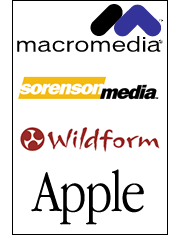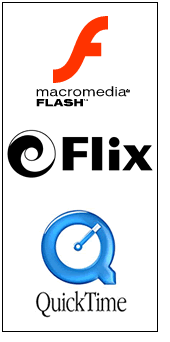
Flix may become the only legal way to stream video in Flash
Scott Manning
May 10, 2002
|
Out of all the video encoders for Flash, Wildform's Flix has remained on top as the most advanced and best selling. Flix has held the crown of video encoders for over a year. Then a new kid on the block showed up - Sorenson.
 Sorenson's ability to compete with Flix was unprecedented by any other company for several reasons. Sorenson teamed up with and received the stamp of approval from Macromedia itself. Sorenson's ability to compete with Flix was unprecedented by any other company for several reasons. Sorenson teamed up with and received the stamp of approval from Macromedia itself.
The following is a timeline of how things have unfolded over the past two years in the video-in-Flash world.
2000
Two years ago everyone thought video in Flash was impossible and attempting to figure it out was a kind of quest for the "holy grail" among some developers in the Flash community.
January 2001
Wildform shocks the Flash world by releasing Flix, the first video encoder for Flash. Flix has the ability to not only encode video in Flash, but also to stream it over predetermined bitrates. With this new technology, Flix not only puts video in Flash, but offers a great alternative to other streaming video players (Real, QuickTime, etc).
February 2001
Wildform unveils Flix to the attendees of FlashForward San Francisco. They received a standing ovation, and drew critical acclaim.
February 2001 - February 2002
As with all new technologies, there were limitations to streaming video in Flash. Even so, Wildform continued to develop its codec and improve Flix. Smaller competitors came and went to the market. Wildform continued to lead the way. The market for video-in-Flash grows.
February 2002
Wildform releases Flix 2, the first application with vector video and Flash 3-5 video output.
Mid March 2002
Macromedia and Sorenson introduce Flash MX with MX Flash video output. Sorenson releases Sorenson Squeeze to enhance MX's video capabilities. There is great excitement in the developer community over the new, native video support in Flash.
 Developers start asking the question, "What do we need Flix for?". Wildform quickly responds by welcoming Macromedia and Sorenson to the video-in-Flash market. They also post an article entitled If I plan on buying Flash MX (Flash 6), why do I need Flix?. The article bullet points everything Flix can do that Flash MX cannot. Developers start asking the question, "What do we need Flix for?". Wildform quickly responds by welcoming Macromedia and Sorenson to the video-in-Flash market. They also post an article entitled If I plan on buying Flash MX (Flash 6), why do I need Flix?. The article bullet points everything Flix can do that Flash MX cannot.
Late March 2002
Two weeks later Wildform releases Flix 2.1 with MX support making it the only product that outputs Flash 3, 4, 5, MX and vector video.
April 2002
Apple sues Sorenson over their Spark codec in Flash. Apple claims they paid Sorenson $4.5 million not to use the codec with any other competitor. With the lawsuit, Apple wants to block Sorenson from using it's codec with Macromedia. Sorenson responds with astonishment over the lawsuit.
May 2002
Wildform releases Flix Pro with Flash FLV video output needed to import Wildform's MX video into Flash (both 1-pass and 2-pass VBR).
That's the drama in a nutshell. What will happen with all of this? If Apple is successful in blocking Sorenson from letting Macromedia use its codec, then Flash MX's video streaming capablities will be gone. The only legal way left to stream video in Flash will be through Wildform's Flix. Although there are other competitors that offer video-in-Flash, none of them offer MX video or FLV.
Several rumors (and I do emphasise rumors) have floated around that Macromedia might drop Sorenson altogether and hire Wildform. Others say Macromedia will find another way without the help of any other company. Only time will tell.
|
